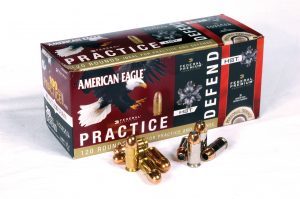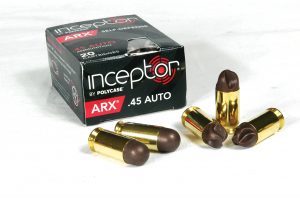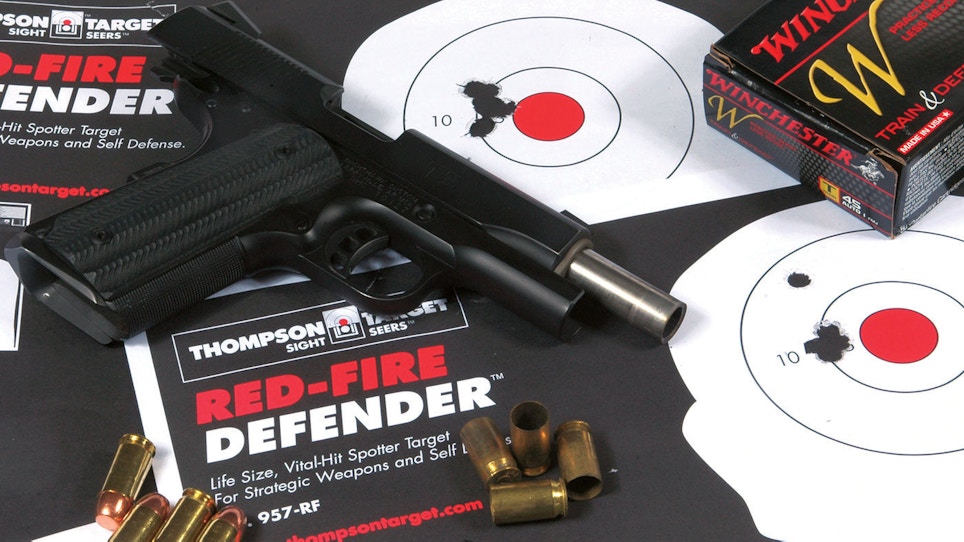In keeping with the industry’s current focus on self defense, one of the trendy buzzwords is “training.” This is good because training items often have a higher margin than firearms and because purchasing a lethal device brings with it a responsibility to learn how to use it competently and safely, which brings us to the relationship between training and self-defense ammunition. Defensive ammo, usually loaded with jacketed hollowpoints (JHP), is much pricier than the full metal jacket (FMJ) or cast lead bullets used for practice. It also has different recoil and point of impact. For example, I shot Black Hills’ excellent .45 ACP +P JHP alongside Winchester White Box and found a 5-inch difference in point of impact at 25 yards.
The difference can be so dramatic that law enforcement agencies have been sued for negligent training when officers qualified with ammo other than what they carried, leading to disastrous results in real life. In a fight, nothing your gun does should surprise you, and any surprises will not be good for you. So, how do shooters who can’t afford to burn endless cases of Hornady TAP realistically prepare to defend themselves?
One helpful trend is manufacturers pairing a duty load with a comparable training round. This is not a unique idea: mechanical broadheads for bowhunting often come with a non-functional practice point.
Federal, for example, offers 20 rounds of its HST hollowpoint packaged with two 50-round boxes of ballistically-matched American Eagle FMJ in their Practice & Defend combo pack, which is available in .380, 9mm, .40 and .45. Originally offered to law enforcement, the HST hollowpoint was released for consumer distribution in 2013 and is advertised as performing well in the FBI’s strict testing protocol.
I conducted an informal range test using the .45 ACP Practice & Defend ammo provided by Federal and a Nighthawk T3 M1911 as the test gun. Since defensive pistol practice isn’t done from sandbags, I shot it by hand.

Federal’s Practice & Defend
ammunition combines 20 of their HST hollowpoints with 100 rounds of ballistically matched American Eagle ball ammunition. The combo packs are available in .380, 9mm, .40 and .45 ACP.
There was minimal change in point of impact. At 25 yards, the ball load hit a couple inches higher and to the right, but that could just as easily have been shooter error. At 7 yards, the HST hit a bit higher with nine of the rounds from the two five-shot groups in or cutting the line of the 15 ring. Similarly, I loaded two magazines randomly with both rounds and shot a group at each distance with no discernable difference on paper or in felt recoil.
Winchester’s W Train & Defend line offered in .380, 9mm, .38 Special, .40, and .45 ACP also combines the two types of ammunition. “W Train & Defend was developed to be a system in that the Training rounds duplicate the same internal/external ballistics as the Defend rounds,” said Mike Stock, Winchester’s director of commercial sales and product management. “They share the same bullet weights, muzzle velocities and very similar bullet profiles, other than the obvious hollowpoint. By doing so, we achieve the same recoil impulse as well as point of impact to allow confident practice.”
The practice round is a flat-pointed FMJ, while the JHP will look familiar to those who have watched Winchester’s reverse-tapered jacket hollowpoint evolve from the six-petaled Black Talon through the Ranger SXT and eight-petaled SXT variants to today’s Defend.
As with the Federal, I shot W Train & Defend at both 7 and 25 yards and found the Defend rounds hit a couple inches left of the Train loads at 25 with no difference at 7. There was also no discernable change in recoil when shooting mixed mags of the hollowpoint and target loads.
The need for comparable practice ammo is most acute with non-traditional rounds, such as lightweight frangible or sintered rounds. Often weighing far less than standard projectiles, the change in weight can lead to dramatically different points of impact.
With that in mind, Paul Lemke, CEO of the innovative PolyCase, told me their Sport & Carry Combo Pack package “was designed to allow our customers the convenience of purchasing 100 cartridges of our Sport Utility Ammo training cartridges with a box of our award-winning Preferred Defense ARX cartridges.”
He went on to say the Sport Utility rounds were designed “to deliver the same recoil and point of aim performance” as the ARX by matching the grain weight and internal ballistics of the two rounds. Available in .380, 9mm, .38 Special, .40 or .45, the ARX uses a lightweight bullet (118 grains in .45 ACP vs. the usual 230) with external flutes instead of a hollow point.

The ARX bullet (right) is a lightweight 118-grain molded alloy-polymer projectile that uses external flutes to disrupt tissue rather than relying on a hollowpoint, which may or may not expand. The pair training load is a roundnose 130-grain bullet of similar construction, minus the flutes.
As a side benefit, while the ARX is non-expanding in soft tissue, both it and the Sport and Utility (RNP) use a copper-polymer projectile with excellent frangibility on hardened steel, so they can be safely used on steel targets at ranges closer than traditional bullets. This is reported as within a foot, but prudence still suggests caution. For the retailer, the Sport & Carry package contains three boxes individually UPC’d for separate sale and costs less than purchasing each box individually, giving the seller some options for resale.
To find out how to pair practice ammo with rounds that do not come already matched, I talked with Buddy Singleton of Southern Ballistic Research (SBR), home of the .458 and .338 SOCOM rounds, as well as the .338 Spectre, a sort of big brother to the .300 Whisper (Blackout). SBR also produces paired training and defensive ammunition for law enforcement agencies.
“Ninety percent of shooting is feel, so it’s got to feel right,” Singleton said, noting that maintaining the same feel breeds confidence, which can often stop a situation from getting to the life-threatening stage. “If you’re confident, it comes across. Ammo-gun-shooter combination is the very heart of everything. If you can’t instill that confidence, you’re lost.”
Singleton suggested finding a practice load with the same bullet weight as the chosen defensive ammo that are also made by the same manufacturer since the two are likely to be loaded similarly except for the bullet. That is how SBR produces paired JHP/FMJ loads: it’s exactly the same load, just with a different shaped projectile. “If you can’t get brand, at least get bullet weight,” he suggested, as weight differences are liable to result in substantial performance changes.
Longtime industry insider John Fawcett, who echoed the need for shooters to be both confident and competent, but said he believed general shooter competency and market pressures also need to be considered.
According to Fawcett, for a beginner, selecting a round matching the recoil of the 125-grain +P Magnums they just bought for their new J-frame .357 isn’t the best choice. Instead, it may be wiser to guide them to lower recoiling target ammo such as .38 wadcutter and full-power .38s before introducing them to the brutal Magnums. What ammo they should carry or if they should carry at all is a separate question, but some careful questioning may give you an idea of whether they’re competent enough to be in the paired-ammo category or if they first need to incrementally increase their shooting skill until they’re ready. For those who are, “it’s what you have available.”
Noting inconsistent ammo availability, Fawcett suggested matching bullet weights and then charting the point of impact at varying distances. Practice at the distance where training and defensive loads hit the same place. That may seem limiting, but accuracy can be practiced at any distance, as Gunsite’s über-close-range “dot drill” proves.
Jeff Hoffman of Black Hills Ammunition took a similarly practical view, noting the greatest problems with training ammo happened when officers carried revolvers and practiced with light .38 wadcutters without ever shooting the stout .357 Magnums they carried. The shocking recoil caused some officers to drop their guns thinking they had blown up — not optimal.
Semi-autos, on the other hand, require a certain minimum level of recoil to function and won’t tolerate much more, so there’s necessarily less of a difference in the recoil impulse; otherwise they won’t work reliably. “What small difference there is,” Hoffman said, “is far less of a variable than the skill of a shooter,” most of which are not skilled enough to notice the variance. Hoffman’s recommendation was to purchase five boxes of the very best duty ammo, shoot four to test for function, then spend as much money as possible on bulk ammo for volume practice. “Nothing makes you as good at anything as proper, correct practice.”
The answer may be a mix of all of these, coupled with a strong individual knowledge of your customer’s needs that will let you suggest the training ammo that best meets their needs, whether it’s paired carry and target loads or a remedial course of fire better tailored to develop them as a shooter so they can reap the benefits of better training ammo.
Featured photo: Winchester’s Train & Defend showed virtually zero difference in point of impact at 7 yards between the hollowpoint (foreground) and FMJ load (background). Even with the flyer, no person shooting either of these will notice the difference in point of impact.






